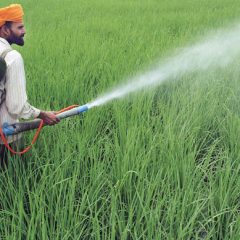Search results for “cancer”:
Maharashtra is one of the major cotton growing areas in India. Most of the cotton planted in recent years has expressed the Bt gene to control certain insects, but a combination of factors including resistance has eroded its efficacy. Between higher priced seed and the need to apply extra insecticide, cotton farmers in the region […]
Read More, References, Comment »
The tagline in the remarkable New York Times story on junk food in Brazil reads: “As growth slows in wealthy countries, Western food companies are aggressively expanding in developing nations, contributing to obesity and health problems.” The Times story appeared September 16, 2017 and is accessible online. The authors, Andrew Jacobs and Matt Richtel, explain […]
Read More, References, Comment »
Andrew Kniss is a professor at the University Wyoming whose research is partially funded by the pesticide and biotech industry. My research over the last ~15 years has been substantially funded by organic food companies, and foundations that hope to support bio-based innovation in agriculture that leads to healthier food and a lighter environmental footprint. (For […]
Read More, References, Comment »
DDT is the chlorinated hydrocarbon insecticide that was developed during World War II and dominated post-war insect pest management for 20+ years. It was the most widely used insecticide in a family of chemistry that included aldrin, dieldrin, toxaphene, chlordane, hepatchor, and a handful of other active ingredients. It was widely regarded as a miracle […]
Read More, References, Comment »
Keywords Site Map Keywords Navigate the extensive content throughout Hygeia Analytics with the following keywords. Click on the link below to access Hygeia content and pdf resources related to each keyword. 2,4-D, About Hygeia, Animals, Antibiotics, Antioxidants, Aquaculture, Bees, Bt, Cancer Risks, Children, Climate Change, Dairy, Dicamba, Dietary Risks, Economics, Environmental Impacts, Farmworkers, Fat, Food Security, GE Impacts on […]
“Vitamin E” — a fat soluble antioxidant playing an important role in protecting the cell membrane, fats, the immune system and vitamin A from oxidative stress. Studies suggest that vitamin E supplementation may improve immune function and reduce the risk of chronic diseases such as heart disease, cancer, strokes.
Read More, References, Comment »
“Vitamin C” — important as an antioxidant but also in its ability to regenerate the antioxidant form of Vitamin E. With acute viral infections (flus, colds), vitamin C can reduce symptom severity and shorten illness time at high levels. Important in the maintenance of bones, teeth, blood vessels and connective tissue as well as enhancing […]
Read More, References, Comment »
“Selenium” — a component of the antioxidant enzyme, glutathione peroxidase. Glutathione peroxidase works with vitamin E in preventing free radical damage to cell membranes. In addition, selenium appears to have antioxidant properties on its own and plays a role in cancer, cardiovascular disease, enhancing immune function, inflammatory conditions, and cataracts.
Read More, References, Comment »
“Carotenoids” – chemicals produced by higher plants that function to protect the plant from the oxygen-based free radicals produced during the absorption of light. Carotenoids also act as pigments to aid in light absorption. In our bodies, carotenoids function to protect our cells from free-radical damage. Several carotenoids enhance immune response, help prevent cancer and […]
Read More, References, Comment »
“Carotenoids” – chemicals produced by higher plants that function to protect the plant from the oxygen-based free radicals produced during the absorption of light. Carotenoids also act as pigments to aid in light absorption. In our bodies, carotenoids function to protect our cells from free-radical damage. Several carotenoids enhance immune response, help prevent cancer and […]
Read More, References, Comment »





